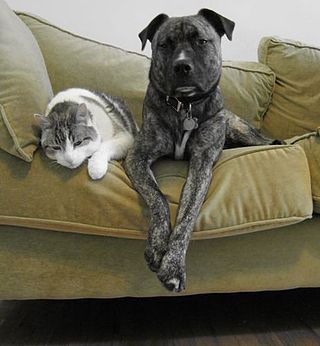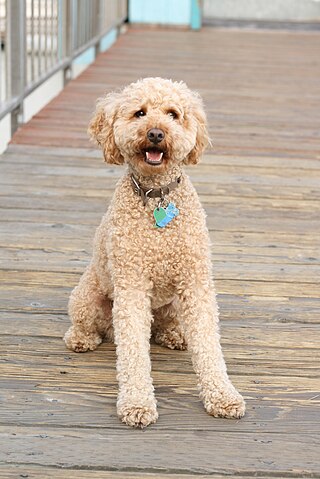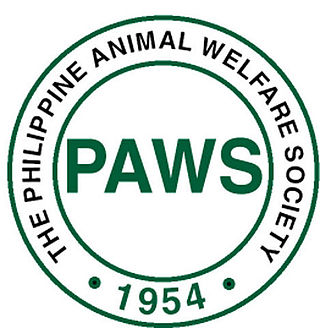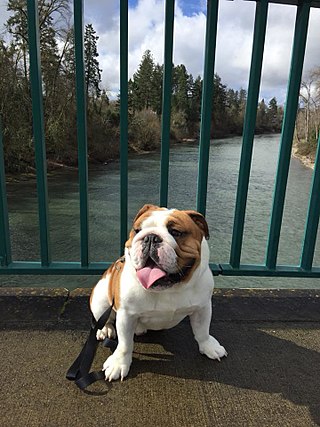
A pet, or companion animal, is an animal kept primarily for a person's company or entertainment rather than as a working animal, livestock, or a laboratory animal. Popular pets are often considered to have attractive/cute appearances, intelligence, and relatable personalities, but some pets may be taken in on an altruistic basis and accepted by the owner regardless of these characteristics.

The Shiba Inu is a breed of hunting dog from Japan. A small-to-medium breed, it is the smallest of the six original breed of dogs native to Japan. Its name literally translates to "brushwood dog", as it is used to flush game.

The Akita is a Japanese dog breed of large size. Originating from the mountains of northern Japan, the Akita has a short double coat similar to that of many other northern spitz breeds. Historically, they were used by matagi for guarding and the hunting of bears.

Pet adoption is the process of transferring responsibility for a pet that was previously owned by another party. Common sources for adoptable pets are animal shelters, rescue groups, or other pet owners. Some organizations give adopters ownership of the pet, while others use a guardianship model wherein the organization retains some control over the animal's future use or care.

The Sapsal is a shaggy-haired South Korean breed of dog that is said to ward off evil spirits. In the Korean language, the word Sapsal is followed by either gae or the nominative particle i, and may occasionally be romanized as Sapsaree. The breed was designated as one of the Natural monuments of South Korea in 1992 to receive protected status and funding for its preservation as a part of Korea's cultural heritage. The breed is officially recognized by the Korean Kennel Federation.

A therapy dog is a dog that is trained to provide affection, comfort and support to people, often in settings such as hospitals, retirement homes, nursing homes, schools, libraries, hospices, or disaster areas. In contrast to assistance dogs, which are trained to assist specific patients with their day-to-day physical needs, therapy dogs are trained to interact with all kinds of people, not just their handlers.

Dog crossbreeds, sometimes called designer dogs, are dogs which have been intentionally bred from two or more recognized dog breeds. They are not dogs with no purebred ancestors, but are not otherwise recognised as breeds in their own right, and do not necessarily breed true.

Greyhound adoption or Greyhound rescue programs focus on finding homes for Greyhounds who are no longer needed for racing. In some countries, they live in kennels at the track.
An animal rescue group or animal rescue organization is a group dedicated to pet adoption. These groups take unwanted, abandoned, abused, or stray pets and attempt to find suitable homes for them. Many rescue groups are created by and run by volunteers, who take animals into their homes and care for them — including training, playing, handling medical issues, and solving behaviour problems — until a suitable permanent home can be found.
In some countries there is an overpopulation of pets such as cats, dogs, and exotic animals. In the United States, six to eight million animals are brought to shelters each year, of which an estimated three to four million are subsequently euthanized, including 2.7 million considered healthy and adoptable. Euthanasia numbers have declined since the 1970s, when U.S. shelters euthanized an estimated 12 to 20 million animals. Most humane societies, animal shelters and rescue groups urge animal caregivers to have their animals spayed or neutered to prevent the births of unwanted and accidental litters that could contribute to this dynamic.

The dog is a domesticated descendant of the wolf. Also called the domestic dog, it is derived from extinct gray wolves, and the gray wolf is the dog's closest living relative. The dog was the first species to be domesticated by humans. Hunter-gatherers did this over 15,000 years ago in Oberkassel, Bonn, which was before the development of agriculture. Due to their long association with humans, dogs have expanded to a large number of domestic individuals and gained the ability to thrive on a starch-rich diet that would be inadequate for other canids.

The loss of a pet or an animal to which one has become emotionally bonded oftentimes results in grief which can be comparable with the death of a human loved one, or even greater, depending on the individual. The death can be felt more intensely when the owner has made a decision to end the pet's life through euthanasia. While there is strong evidence that animals can feel such loss for other animals, this article focuses on human feelings, when an animal is lost, dies or otherwise is departed.

The Kishu, sometimes called Kishu Inu or Kishu dog, is a Japanese breed of dog. It is descended from ancient medium-sized breeds and named after the Kishu region, now Mie Prefecture and Wakayama Prefecture. It was designated a living national monument of Japan in 1934. Kishu have been prized since prehistoric times for boar and deer hunting. Like the Shiba, they are often quiet. Kishu will stalk prey quietly rather than bark. They are the most commonly used purebred native Japanese breed used for hunting boar to this day.

The Philippine Animal Welfare Society (PAWS) is a volunteer-based, non-government organization whose goal is to prevent animal cruelty through education, animal sheltering and advocacy, based in Quezon City, Philippines. It was founded in 1954 by Muriel Jay. PAWS believes that the creation of a more peaceful society starts with the widening of mankind's circle of compassion which includes animals, thereby envisions a nation that respects animals, practices responsible pet ownership and protects wildlife. The volunteer-based organization rehabilitates these animals in the hope of finding them new homes and a second chance at a good life. PAWS does not take in pets of other people, but only victims of cruelty or neglect where the animal offenders are charged with violation of the Animal Welfare Act in court.

Pet rental is the practice, usually administered by for-profit companies, of renting pets such as dogs and cats. Rental also includes animals who are hired out at a specific rate for a specific time. It is a controversial practice opposed by many animal rights advocates and has been banned in at least one municipality: Boston, Massachusetts.

The Pug is a breed of dog originally from China, with physically distinctive features of a wrinkly, short-muzzled face, and curled tail. The breed has a fine, glossy coat that comes in a variety of colors, most often fawn or black, and a compact, square body with well developed and thick muscles all over the body.

Hundreds of millions of cats are kept as pets around the world.

Inu no Osanpo (犬のおさんぽ), is a dog walking simulation game developed by Wow Entertainment and published by Sega for the Sega NAOMI arcade system in 2001. Players "walk" a virtual dog by walking on a treadmill and control the pet with a leash attached to a plastic dog in front of the player. The game was only released in Japan.
Pet culture refers to the culture revolving around the interaction of humans and pets.

The Kawakami Inu is a small, Japanese dog breed originating in Kawakami Village, Minamisaku District, Nagano Prefecture. It is considered to be a type of Shiba Inu and is designated as a natural monument of Nagano Prefecture.

















